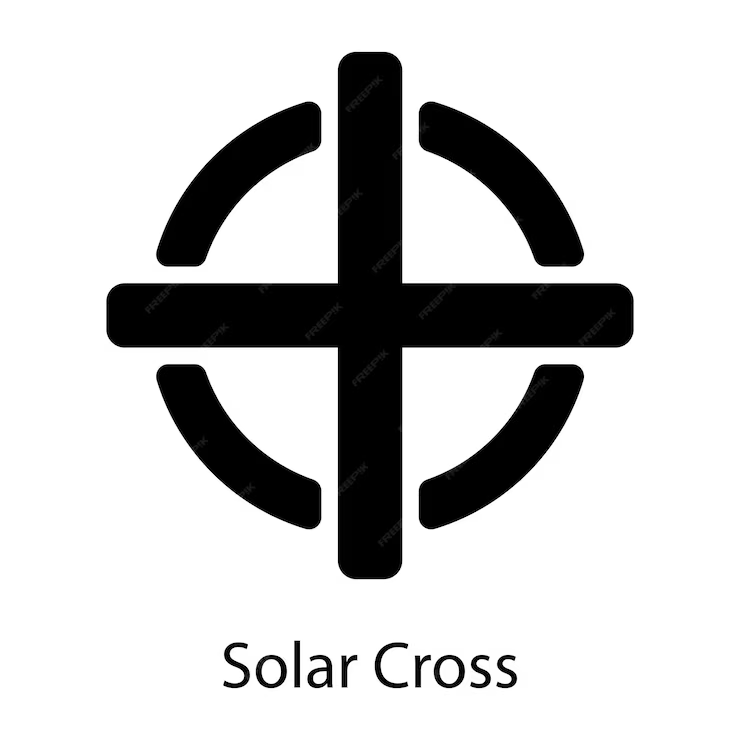The “solar cross” is a symbol that dates back thousands of years, rich in meaning and historical significance. It is one of the oldest known geometric symbols, predating most modern religions and cultures. The symbol has endured through centuries, making it a remarkable part of human heritage. In this article, we will explore the origins, meanings, and various uses of the solar cross, comparing it to other ancient symbols to understand its role in different cultures.
What is the Solar Cross?
The solar cross consists of a simple design: a cross inscribed within a circle. It often represents the sun, a key figure in many ancient religious and spiritual traditions. The circle is typically interpreted as the sun itself, while the cross can represent the four cardinal directions, which in turn relate to the seasonal shifts of the Earth. This symbol can be found across a wide array of ancient cultures. From pre-Columbian Americas to ancient Europe and Asia.
In its most basic form, the solar cross is seen as a powerful symbol of life, death, rebirth, and cosmic order. It embodies the balance and cycles that govern existence, especially the annual solar cycle that affects all living things.
Origins and History of the Solar Cross
The solar cross appears in archaeological sites from diverse cultures and civilizations. It is widely believed that the symbol emerged in the Neolithic era, around 5,000 years ago. Some of the earliest instances of the solar cross have been found in the megalithic art of Europe, where it was used to mark solstices or ceremonial events tied to the movement of the sun.
In ancient Europe, the solar cross was seen as a representation of the cosmic order. The sun’s energy, and its power over nature. The Druids and other ancient European cultures used the symbol during solstice celebrations. Connecting the circle and cross to the sun’s cycle of life and death.
Similarly, in the ancient world, particularly in Mesopotamia and Egypt, the solar cross represented not only the sun but also its relationship to the four cardinal directions, symbolizing balance and harmony in the world. The cross was also a metaphor for the intersection of the heavens and the Earth, where the divine and the earthly realms met.
Solar Cross in Various Cultures
The solar cross has different interpretations depending on the cultural context. Let’s explore how various ancient cultures used and understood the solar cross.
- Ancient Europe: In European traditions, the solar cross was often associated with pagan rituals and deities, particularly those related to the sun. It symbolized the eternal cycle of the sun and was used in rituals that marked key points in the solar year, such as solstices and equinoxes.
- Native American: The solar cross has also been found in Native American iconography. Particularly among the Hopi and Zuni tribes. Here, the symbol is often associated with the four cardinal directions and the cyclical nature of time. Representing the integration of both the spiritual and physical realms.
- Ancient Egypt: The Egyptians used similar imagery in their sun worship practices, particularly the ankh and the sun disc, which often resembled a solar’s cross. The Egyptians viewed the sun as a symbol of life and regeneration, tied to the gods Ra and Aten.
- Ancient China: In Chinese philosophy and art, the solar’s cross can be seen as part of a broader cosmic order. The circle symbolizes the sun, while the cross relates to the concept of balance between opposites, such as the forces of Yin and Yang.
- Pre-Columbian America: Various indigenous peoples in the Americas, particularly the Incas and Aztecs, used circular and cross-like symbols to represent the sun, their gods, and the natural cycles of life. These symbols often appear in religious and ceremonial contexts, representing the sun’s role in providing light and fertility to the earth.
The Meaning Behind the Solar Cross
The solar cross can be interpreted in various ways, depending on its context. However, there are some consistent themes throughout history.
- Solar and Cosmic Power: The sun has been a key symbol in human cultures, often associated with life, power, and vitality. The solar’s cross embodies the sun’s influence on life on Earth and its power over time and seasons.
- Balance and Harmony: The solar’s cross, particularly with its cross design, is often a symbol of balance. The four arms of the cross represent the cardinal directions—north, south, east, and west. While the circle symbolizes the sun, the unifying force in the universe.
- Cycles and Renewal: The solar’s cross is also a symbol of the cyclical nature of existence. Just as the sun rises and sets, the seasons change, and life is continually renewed. The cross within the circle can be seen as a reminder of this cycle. Where endings are inevitably followed by new beginnings.
- Spiritual and Physical Realms: The solar cross often represents the intersection of the spiritual and physical worlds. In this context. The symbol is a bridge between the divine (represented by the circle) and the human (represented by the cross), linking the heavens and the Earth.
Solar Cross vs. Other Ancient Symbols
While the solar’s cross is a powerful and ancient symbol, it is far from the only one that represents cosmic and spiritual themes. Below is a comparison chart of the solar’s cross with other prominent ancient symbols:
| Symbol | Meaning | Cultural Origins | Representation |
| Solar Cross | Sun, cosmic order, balance, cycles | Europe, Asia, Native American, Egypt | Cross within a circle |
| Ankh | Eternal life, divine power, sun | Ancient Egypt | Cross with a loop on top |
| Swastika | Sun, life, good fortune, movement of time | India, Europe, Native American | Cross with arms bent at 90° |
| Pentagram | Earth, spirit, five elements | Various cultures | Five-pointed star |
| Ouroboros | Eternal cycle, life and death, regeneration | Ancient Egypt, Greece | Snake eating its own tail |
The solar’s cross is distinct in its focus on the sun, the four directions, and the cyclical nature of time. Other symbols, such as the swastika or the ankh, carry different connotations but share a common theme of cosmic power and spiritual significance.
Solar Cross in Modern Culture
The solar’s cross, while ancient, still holds relevance in contemporary culture. It is often used in various forms of art, jewelry, and tattoos. Some modern-day spiritual groups also use the symbol in their practices, connecting it with ideas of enlightenment. Personal growth, and the recognition of natural cycles.
In recent years, the solar’s cross has seen a resurgence in alternative spiritual movements. Where it is adopted as a symbol of the connection between the individual and the universe. Its simple design and deep meaning make it a versatile and powerful symbol in modern times.
Conclusion
The solar’s cross is one of the most enduring symbols of human culture, connecting ancient beliefs with modern-day spiritual practices. Its simple yet profound design has captivated the imagination of people across the globe. Representing the sun, cosmic order, balance, and the eternal cycles of life. Understanding the history and meaning of the solar’s cross gives us a deeper appreciation of the ways in which humanity has long sought to understand the forces of nature and the universe.

